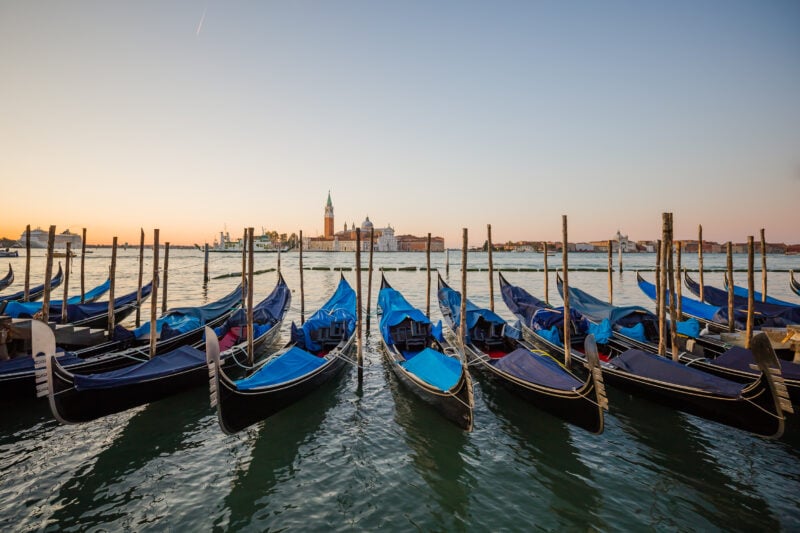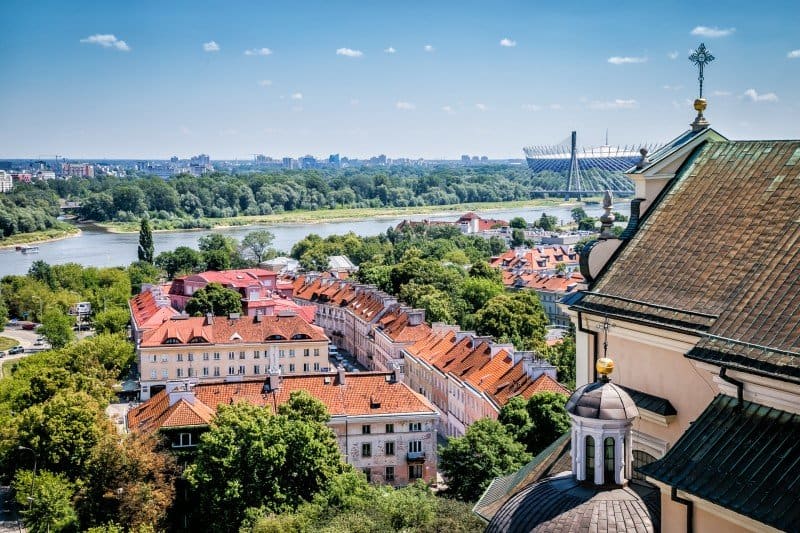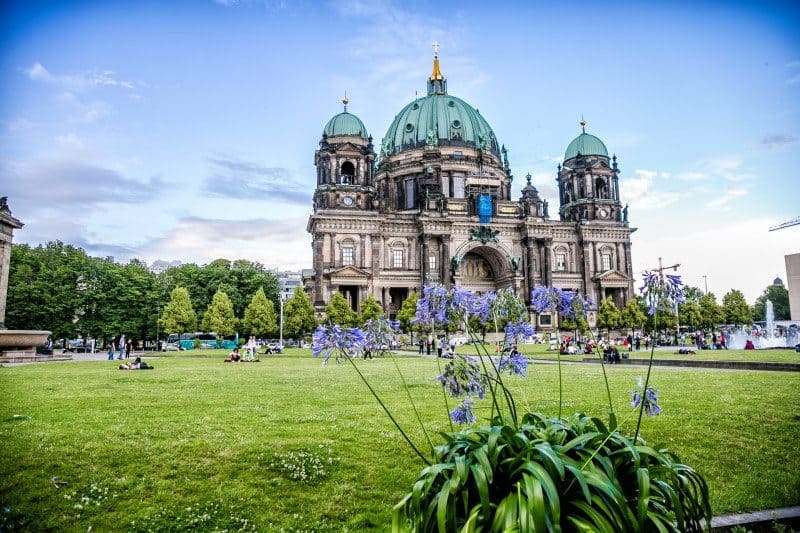When is the best time to visit Europe? The answer is not one size fits all! Truthfully, Europe can be visited year-round and the time to travel to Europe depends on what you hope to do while you’re there and your travel style and budget.
Between the two of us, we have spent months traveling in Europe and have visited during all of the seasons.
Collectively, we’ve visited Europe 15 times and have spent time in 20 European countries. We both love Europe and each time we visit, realize we will spend our lifetimes exploring new places on each visit.
The traveling year in Europe is divided into three seasons for travelers: peak season, shoulder season, and off-season. Each one of these varies depending on what region you plan to visit.
What might be a high season for one country, can actually be a shoulder or a low season for another.
As you’ll quickly learn when you start planning your trip, each season varies from the other and offers its own pros and cons for travelers.
The best time to visit Europe will really come down to your own preference and the country you are visiting.
So, When is Your Best Time to Visit Europe?
Table of Contents

The short answer? Anytime is a good time to travel to Europe but for most people, the shoulder season will be the best time to visit.
We are lucky enough to have flexible jobs and lifestyles to pick when we discover Europe, others do not have that chance. You can easily travel to Europe 365 days a year and each season will offer different experiences and adventures.
While we love to visit Europe in the summer, you cannot beat the weather, we openly admit the crowds are tough to deal with.
This makes early Fall, in our opinion, the best time to visit Europe. No matter when you decide to visit though, you’ll enjoy amazing sites and culture.
Let’s dive into the pros and cons of each season in Europe so you can figure out the best time to plan your trip.
Don’t leave home without: Lonely Planet Europe (Travel Guide)
The Best Time to Visit Europe – Regional Breakdown

To break down the best time to visit Europe we have split the continent into 5 different regions including Northern Europe, Southern Europe, Western Europe, Eastern Europe, and Central Europe.
Each region has its own best time to visit and even though you may be visiting Southern Europe in May or let’s say October because it’s the best time to visit, it does not mean it’s the best time to visit Eastern Europe.
Below we will highlight the different travel seasons based on high, low, and shoulder seasons hopefully giving you enough information on when is the best time for you to visit Europe to pick the best time for you.
Before we get into things we also want to highlight what it means when we say high season, shoulder season, or low season.
- High Season: This is when things are the busiest and things cost the most.
- Shoulder Season: This is when tourism is just starting up again or it is slowing down. Things tend to be a little quieter and a little less expensive.
- Low Season: This is when tourism is at its slowest, there are fewer visitors, and things may cost less but not all attractions may be open.
The Best Time To Visit Northern Europe
Northern Europe is a lot like most of Europe – it is extremely popular to visit during the summer.
The weather is enjoyable, yes it can be hot, and it will be extremely busy everywhere but travelers who visit during this time of the year can take advantage of the long daylight hours and the nice weather.

We love to visit Northern Europe in the shoulder season because the weather is a little cooler and there are fewer travelers. It is also the best time to enjoy many of the outdoor activities across Northern Europe.
Winter in Northern Europe can be very cold, so if you are visiting Northern Europe in the winter, be sure to pack extra warm clothing.
Many locations adjust their hours to the shortened daylight hours and a few may even close their doors until spring.
Northern Europe Quick Highlight:
Northern Europe includes the Netherlands, Belgium, Sweden, Norway, Finland, Denmark, and Luxembourg.
- High Season: June-August
- Low Season: November-April
- Shoulder Season: May, September-October
Average temperatures per season:
- Summer (June-August): High 22°C, Low 13°C
- Autumn (September-November): High 11°C, Low 6°C
- Winter (December-February): High 1°C, Low: -4°C
- Spring (March-May): High 11°C, Low 2°C
The Best Time To Visit Western Europe
Summer in Western Europe is when the weather is enjoyable, however, it is extremely busy. We strongly suggest booking everything several months in advance when traveling during the high season in Western Europe.
Traveling during the shoulder season is a shake of the dice, you could have amazing weather, or it could be wet and miserable.
If you’re willing to take the chance on the weather, the crowds in Western Europe start to thin out during the shoulder season.

Expect to get great deals on accommodation and flights during the off-season in Western Europe.
Many tourist attractions and shows close down over the winter months during the off-season in Western Europe.
Beyond the Christmas Markets in December, it is not the most popular time to visit but people do. Honestly, January and February are probably the only times you can visit Western Europe and not deal with the crowds these days.
It is best to make sure if you have your heart set on something that you triple-check if it is running or that it is open during this time of the year
Western Europe Quick Highlight:
Western Europe includes England, Scotland, Wales, Ireland, Northern Ireland, and France.
- High Season: Mid-June-August
- Low Season: November-March
- Shoulder Season: April-Early June & September-October
Average temperatures per season:
- Summer (June-August): High 24°C, Low 14°C
- Autumn (September-November): High 14°C, Low 7°C
- Winter (December-February): High 5°C, Low 0°C
- Spring (March-May): High 14°C, Low 5°C
The Best Time To Visit Central Europe
Central Europe is one of those places where they get a full range of the four seasons throughout the year. Not everywhere in Europe gets that.
Just like all the other places in Europe, the weather during the summer is amazing making it a high season along with an added high season during the Christmas Market time of the year (middle of November- end of December).

Visiting Central Europe in the spring or fall will offer cooler weather in the early mornings and at night with the middle of the day being warm.
There will be fewer travelers in many of the popular cities during the shoulder season but expect wet or cool days.
During the winter months, the popular places in the summer flip from historic cities to mountainous ski villages.
Central Europe Quick Highlight:
Central Europe includes Germany, Switzerland, and Austria.
- High Season: June-August & End of November – December (Christmas Markets)
- Low Season: January-April
- Shoulder Season: April-May & September to Early November
Average temperatures per season:
- Summer (June-August): High 24°C, Low 14°C
- Autumn (September-November): High 14°C, Low 7°C
- Winter (December-February): High 5°C, Low 0°C
- Spring (March-May): High 14°C, Low 5°C
The Best Time To Visit Eastern Europe
Visiting Eastern Europe in the summer is extremely popular, summers are nice and warm. Many locals head out of town to the countryside to escape the extreme heat.
This makes even the most remote places busy besides the popular cities. We have found that on our last couple of visits, visiting Europe without crowds is more of a fantasy these days.

Traveling during the spring or fall is a great option since this is the shoulder season. Many visitors take advantage of this time of the year but keep in mind spring comes late in Eastern Europe and Fall comes early.
In Winter, the daylight hours are limited, and many popular places adjust their times due to the lack of travelers but also to match when the sun goes down.
So be sure to check all opening hours while visiting Eastern Europe during this time of the year. The weather can also be extremely unpredictable and cold during this time of the year, so make sure to pack warm clothing.
Eastern Europe Quick Highlight:
Eastern Europe includes Poland, Czech Republic, Hungary, Slovakia, Croatia, and Russia.
- High Season: July-August & End November – December
- Low Season: January-Early April
- Shoulder Season: Mid April-Mid June & September – October
Average temperatures per season:
- Summer (June-August): High 25°C, Low 14°C
- Autumn (September-November): High 13°C, Low 5°C
- Winter (December-February): High 0°C, Low: -6°C
- Spring (March-May): High 14°C, Low 4°C
The Best Time to visit Southern Europe
One magical thing about Southern Europe is that it’s a great place to visit year-round. The problem is that means it’s harder for a traveler to take advantage of the seasons since the weather is always nice.
Summer in Southern Europe is stunning and that means lots of locals and tourists enjoy the weather.
This means large crowds and long queues everywhere, so we suggest taking the road less traveled and try finding yourself a hidden spot. The last time we visited Italy and Greece, though, this was very hard.

Both of these countries are absolutely bursting with tourists, and while I won’t say you shouldn’t go, definitely manage your expectations for both.
Shoulder season in Southern Europe can be as popular or busier than summer because the weather is a bit more enjoyable, you don’t get that extreme heat during this time of the year.
We love visiting Southern Europe during the spring and fall. There is bright green in the spring, with cooler mornings and nights.
During the fall it’s a bit dryer and is a great time to go hiking or enjoy the outdoors.
Winter in Southern Europe is amazing. Many big cities are quieter since locals and visitors head to the mountains for winter activities like skiing.
Southern Europe Quick Highlight:
Southern Europe includes Spain, Portugal, Italy, and Greece.
- High Season: Mid June – September
- Low Season: October – March
- Shoulder Season: April – Early June
Average temperatures per season:
- Summer (June – August): High 30°C, Low 17°C
- Autumn (September – November): High 20°C, Low 10°C
- Winter (December – February): High 7°C, Low 0°C
- Spring (March-May): High 18°C, Low 7°C
Best Time to Visit Europe – Seasonal Breakdown
Visiting Europe During the Summer

Arguably, visiting during the summer is one of the best times to visit Europe. This also makes it the peak season running from mid-June to late August.
With iconic monuments, sunny weather, and long days all added together this time of year, it’s no wonder that travelers flock to Europe in the summer.
It goes without saying that you can expect large crowds of travelers and temperatures high enough to melt that scrumptious scoop of gelato right off the cone.
Expect long lines, full restaurants, and photographs with lots of people in them. These things alone can make traveling during peak season unpleasant and at times, unenjoyable.

Unpopular opinion: We do not enjoy traveling in Europe during the summer anymore. It is SO crowded and expensive. It is hard to find hotel bookings, seats at restaurants, and day trips are sold out. We generally tend to avoid summer in Europe when planning our own travels. If you see us there during these months, it is solely for work.
Summer calls to all types of travelers and it is not uncommon to see the entire spectrum walking down the street at one time, backpackers, families, students, and couples alike.
With all of those travelers it can be hard to avoid the large crowds but here are our tips to help avoid large crowds in Europe during the summer peak season.
Europe Summer Travel Tips

- Allow for extra time while traveling during peak season
- Head to the iconic places as early or late as you can each day. It makes for early or late days but it’s so worth it to enjoy a place without crowds.
- Avoid the places that run summer promotions or deals. It’s great to save money but they are likely tourist traps and will be very crowded.
- Make your plans far in advance for the best rates and availability. Last-minute bookings will cost you a fortune and probably end you outside the best areas.
- Rent a car and spend the night in the cities that people normally just visit on a day trip. You’ll be shocked at how quiet the places become when the buses pull out around 5 pm each day.
- See Europe by train with a Eurail pass. No long wait times at the airport and no overpriced taxi rides. The trains run, for the most part, between the city centers saving you time and money. Be sure to make reservations early if required for your chosen route to ensure a seat during peak season.
- Buy snacks from the grocery store to make your own sandwiches and have a picnic outside, away from the crowds.
Need to book a car for your road trip adventure? We use Discover Car Hire for comparing car prices to find the best deal. They search both local & international rental companies.
Be Prepared for Summer Showers

Do not forget your rain jacket and be ready for rain in Europe in the summer. We have had the most rain in three years of travel while traveling in Europe during the summer.
Don’t let the rain ruin your trip, just plan for it and wait it out. There were many times when we waited out the rain and it eventually passed into a beautiful sunny day.
Be Prepared for Crowds
Yes, there may be horrible crowds at some destinations but viewing iconic places during their ideal season cannot be rivaled by any other experience.
Peak season offers the best weather and longest days possible to maximize your sightseeing and vacation days during your travels. Perhaps summer is the best time to travel to Europe for your travels, you’ll just have to decide for yourself.
Hours of Daylight in Europe during Summer
10-14 hours depending on how far north you get.
Weather
Hot and Rainy
Essential Items to Pack
- Rain Jacket
- Umbrella
- Waterproof shoes
- Pants
- Shorts
- Long sleeve shirts
- Short sleeve shirts
- Sunscreen
- Water bottle
Pack like a pro! Ultimate Europe Summer Packing List
Visiting Europe During the Shoulder Season

Shoulder season is typically from April to mid-June and September to early November. Shoulder season varies by destination throughout all of Europe and is a good choice if you have time during these periods.
The advantages come with decent weather, long-enough daylight, and a dramatic decrease in crowds.

Although on our latest shoulder season visit in November 2022, we were in Rome and there were so many people (see photo above). The streets were literally full of people and there were huge lines at every site.
We asked several locals if this was tied to a special event, local days off, etc and the answer was overwhelmingly, no. This is the new normal in Europe post-pandemic.
So while we might get some relief going in the non-summer months, it feels like the shoulder season has merged with the high season in many places.
Is traveling to Europe in Spring or Fall better?
You will have to consider your destination. Both weather and crowds can be the same throughout Europe this time of year.
Europe is generally dark green in the springtime with lots of flowers however it can be wet and cold. In the fall, plants start to brown up.
For outdoor lovers like us, the fall is the best time to discover places like the Alps since many hiking trails are covered with snow throughout late spring. In the fall you can also get crisp blue skies for some great photography. For example, we hiked the Alta Via 1 in the Italian Dolomites in late September.
Money Savings in Shoulder Season
No matter your budget, traveling during the shoulder season will be kinder on your wallet. You’ll find more deals and better availability than traveling in peak season.
The trade-off is sometimes cold hotel rooms, so pack something warm to sleep in, and shortened restaurant hours.

Hours of daylight in Europe during Shoulder Season
10-11 hours
Weather
Prepare for a wide spectrum of weather with cool days that can peak hot and generally cold evenings and nights.
Essential Items to Pack
Pack for hot, cold, and wet weather. Packing with layers of clothing is key to enjoying the shoulder season.
This includes long sleeve shirts and pants. Bring a rainproof jacket, bring only a few pairs of shorts, waterproof shoes and don’t forget an umbrella.
You’ll have to ask yourself, is shoulder season the best time to visit Europe for me after reading this information? That’s the best way to decide what you’re willing to compromise on.
Visiting Europe During the Winter

Traveling in Europe in the off-season may be the best option for the traveler who does not want to deal with the large crowds or the high prices. With the exception of the Christmas Market season, of course.
Winter in Europe lasts from November to late March, peaking in December before the holidays due to the Christmas Markets, and is the cheapest time to visit Europe.
Expect to spend less while traveling in the off-season as airfares are normally hundreds of dollars cheaper and with the crowds thinning out you will find many of those expensive hotels drop their prices too.
Keep in mind that many bed and breakfast places or small boutique hotels may be closed, those that are still open will be empty and more comfortable than in the peak season. The same can be said for restaurants.
Many of the busy top tourist locations will be empty and you will enjoy taking your time in the museums without being pushed between rooms. Again, after the Christmas market season ends.
Winter travelers in Europe will be spoiled with walk-up service at shops and tourist sites, unlike traveling during the peak and shoulder seasons.
Although there is a risk that popular tourist-oriented parks, shows, and tours will be closed so make sure you check in advance.

It will get dark early and light later, so your days are shorter. The weather can be a gamble and maybe at times be downright miserable, cold, windy, and drizzly.
Packing can be hard because of the different types of weather. Dress warmly for cold weather, since most iconic sites are outdoors.
Most hotels are not equipped with great heating systems so in the off-season, it can be cold in many hotel rooms. Smaller towns can turn into ghost towns during the off-season and may be shut down to tourists.
This can lead to frustration so it is very important that you confirm all your plans ahead of time. The off-season can be the best time to travel to Europe for the right traveler and offer many rewarding experiences and a unique look at many iconic cities and sights.
Worth Noting
While it will be cold and you’ll certainly have snow, the off-season can be the best time to visit Scandinavia for dog-sledding and Northern Lights viewing.
Hours of daylight during the Winter
8-7 hours
Weather
Cold and damp.
Essential Items to Pack
Pack for cold and wet. Wear layers of clothing, bring a rainproof jacket, gloves, a stocking hat, long johns, good socks, long sleeve shirts, a good jacket, pants, waterproof shoes and don’t forget an umbrella.
Related Article: Ultimate Guide to Eurail Pass Train Travel in Europe
How to Decide The Best Time to Travel Europe

Here are a few questions to consider as you start planning your European getaway.
- What countries am I going to visit?
- What activities are most important?
- Do I want fewer crowds or better weather?
- Do I plan to spend time at the beach?
- Do I want to ski or visit Christmas markets?
- What is my budget?
Answering these questions will help you get clear on the best time to plan your trip to Europe. If you want the best weather for sunbathing or swimming, you’ll definitely want to plan a summer getaway.
If your goal is to avoid large crowds, look to the shoulder season. And if you want Christmas markets and snow, the winter is your chance!
Europe Travel FAQs
It will depend on what you want to do but in general, May and September are the best months to visit Europe. The weather is usually good, most things are open, and there are fewer crowds.
November to February is typically the cheapest time to travel to Europe, with the exception of the few weeks around Christmas and the ski resort towns.
July to September is the best time to visit Europe if you want a beach vacation. June is okay as well but the water is still very cold. Good for sunbathing but not so much swimming!
The shoulder season is typically the best time to visit the cities. You won’t have to deal with the big crowds and things tend to stay open even during the off-season in the big cities.
December is definitely the best time to head to Europe for the Christmas markets, though some do begin to open up in November and stay open through the first week of January.
You might also like:
- 10 Cheapest Places to Travel in Europe
- The Only Europe Packing List You Need (For Any Season!)
- Train Travel in Europe: Ultimate Eurail Pass Guide
- 15 Best Cities in Europe to Visit
- Travel Insurance for Europe Vacation: Do You Need It?
- Viking River Cruises in Europe: What to Expect
- 10 Adventures for Your Europe Bucket List


Wow! You speak my life! Thank you for posting… I am in tears just can’t believe I came upon this website!
Too cold or too many tourist. Europe is a tricky place to plan a visit. We’ve planned our travels to Europe around events like Oktoberfest, etc or have begun to seek out secondary cities. Yes you’ll run into crowds at major festivals, but you know what you are getting yourself into. With secondary cities you can avoid most of the crowds during the high season.
I agree with you. The amount of tourists in the summer season, in major cities, is exhausting. Secondary cities is a great way to soften that up a little. 🙂
We will be traveling Europe in mid April(17 Apr thru 14Mzy) mid May 2018. We my wife and I Fly into CDG and start our Eurail Global Pass good for one month.The question is our baggage?We are on WOW Airline and they are not much on baggage at all. I tried shipping our bags to the hotel in Paris we will spend our first night. That was not possible. So would like some words of wisdom.
The best advice I can give you is to pay the excess baggage fees with the airline. Once you get to Europe you will have no problems bringing your luggage on the train, as long as you aren’t packing too much. There are places to do laundry in Europe, so I would recommend really cutting down on what you bring- just bring a few outfits and plan to do laundry. This will reduce the amount of luggage you bring too. Best of luck and enjoy your travels in Europe!
I was recently in London during January. At first I was concerned that rainy London would be even more gloomy during the winter, but it actually turned out to be a fantastic time to visit! A lot of what you mentioned was true, plus there were more bonuses for traveling in the off season. Accommodations were cheaper. I never waited in a line. Photographs weren’t cluttered with strangers. Sometimes I was the only person in an exhibit! Best of all? There were plenty of beautiful, sunny days.
Weather, costs and the amount of daylight have been my biggest considerations for when to visit Europe. Based on all that there’s not a bad time it’s just weighing the pros and cons of each season and specific location. You do a great job of this. Bookmarking this for when we actually make it out there. Cheers!
Great to hear, Mark. Yes, it really comes down to your preferences when you travel. Traveling around Europe in all seasons can be rewarding and of course it depends on what countries you want to visit. Each region having different high/low/shoulder seasons from others. Cheers!
This was very helpful. Great info.
Great to hear! Thanks for stopping by.
Wow! What an amazing amount of information you’ve shared! I will pin this so I can refer back if I ever get to Europe!
Thanks Jennifer! That is our aim, to provide useful information to help people travel more! Thanks for sharing and feel free to reach out if you ever need help planning an itinerary. Cheers-Lina